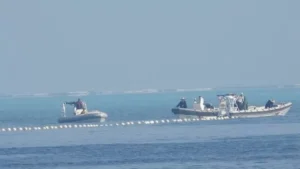Tensions Escalate in South China Sea as Philippines Dismantles Chinese Barrier

In a significant development that could have far-reaching implications, the Philippines has taken decisive action in the ongoing South China Sea dispute. President Ferdinand Marcos Jr. has authorized the removal of a “floating barrier” installed by China near the Scarborough Shoal, an area hotly contested by multiple nations.
The move was carried out by the Philippine coastguard in what they termed a “special operation.” Their objective: to uphold international law and protect the rights of Filipino fishermen. The barrier, stretching approximately 300 meters (1,000 feet), was seen as a navigational hazard and a clear breach of international maritime regulations.
The Scarborough Shoal, known locally as Bajo de Masinloc, holds a special place in the hearts of Filipinos, as it is considered an integral part of their national territory. The removal of this barrier was a significant step toward reaffirming their sovereignty over the area.

This latest incident underscores the ongoing dispute over the South China Sea, where China asserts sovereignty over approximately 90% of the region. This expansive claim conflicts with the exclusive economic zones of neighboring countries, including Vietnam, Malaysia, Brunei, Indonesia, and, in this case, the Philippines.
The Philippines’ Department of Foreign Affairs has condemned the barrier’s installation as a violation of international law and pledged to take all necessary measures to protect the nation’s sovereignty and the livelihoods of its fishermen.
Philippine Coast Guard Successfully Removes Hazardous Floating Barrier in Compliance with Presidential Instruction
In compliance with the instruction of the President, the Chairman, National Task Force for the West Philippine Sea (NTF-WPS), Sec. Eduardo Año, has directed the… pic.twitter.com/loeeFm45sU
— Jay Tarriela (@jaytaryela) September 25, 2023
The Scarborough Shoal has been a flashpoint in the South China Sea dispute. In 2012, China seized control of the area, pushing Filipino fishermen further from their traditional fishing grounds. This latest move by the Philippines signals a renewed determination to assert its rights under international maritime law.
As this situation continues to unfold, it further underscores the complexity and volatility of the South China Sea dispute. The international community, including the United States, which has interests in the region, will be closely monitoring developments and urging peaceful resolutions to such conflicts in this critical geopolitical hotspot.









